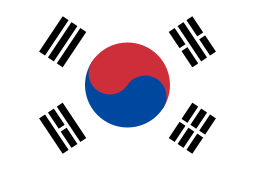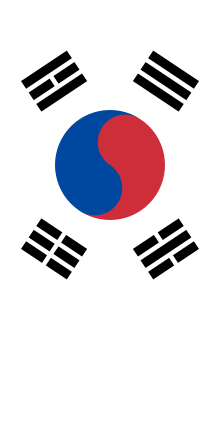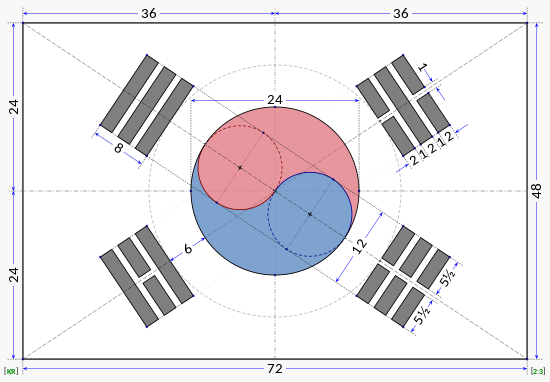Flag of South Korea
 | |
| Name | Taegukgi / Taegeukgi (Korean: 태극기) (Hanja: 太極旗) |
|---|---|
| Use | National flag and ensign |
| Proportion | 2:3 |
| Adopted | January 27, 1883 (original version, used by the Joseon dynasty) June 29, 1942 (Provisional Government of the Republic of Korea) October 15, 1949 (as the flag of South Korea)[1] October 1997 (current version) |

Variant flag of South Korea
| |
| Use | Naval jack |
| Flag of South Korea | |
| Hangul | 태극기 |
|---|---|
| Hanja | 太極旗 |
| Revised Romanization | Taegeukgi |
| McCune–Reischauer | T'aegŭkki |
Contents
[hide]Symbolism[edit]
The flag's background is white, a traditional color in Korean culture. White was common in the daily attire of 19th-century Koreans, and it still appears in contemporary versions of traditional Korean garments, such as the hanbok. The color represents peace and purity.The circle in the middle is derived from the philosophy of yin-yang and represents balance in the universe. The red half represents positive cosmic forces, and the blue half represents the opposing negative cosmic forces.
Together, the trigrams represent movement and harmony as fundamental principles. Each trigram (hangeul: 괘 [gwae]; hanja: 卦) represents one of the four classical elements,[2] as described below:
| Trigram | Korean Name | Celestial Body | Season | Cardinal Direction | Virtue | Family | Natural Element | Meaning |
|---|---|---|---|---|---|---|---|---|
| ☰ | geon (건 / 乾) | heaven (천 / 天) | spring (춘 / 春) | east (동 / 東) | humanity (인 / 仁) | father (부 / 父) | heaven (천 / 天) | justice (정의 / 正義) |
| ☲ | ri (리 / 離) | sun (일 / 日) | autumn (추 / 秋) | south (남 / 南) | justice (의 / 義) | daughter (녀 / 女) | fire (화 / 火) | fruition (결실 / 結實) |
| ☵ | gam (감 / 坎) | moon (월 / 月) | winter (동 / 冬) | north (북 / 北) | intelligence (지 / 智) | son (자 / 子) | water (수 / 水) | wisdom (지혜 / 智慧) |
| ☷ | gon (곤 / 坤) | earth (지 / 地) | summer (하 / 夏) | west (서 / 西) | courtesy (례 / 禮) | mother (모 / 母) | earth (토 / 土) | vitality (생명력 / 生命力) |
History[edit]

The issue remained unpursued for a period, re-emerging with the negotiation of the United States–Korea Treaty of 1882, also known as the Shufeldt Treaty. The controversy arose after the delegate Lee Eung-Jun presented a flag similar to the flag of Japan to the Chinese official Ma Jianzhong. In response to the discussion, Ma Jianzhong argued against the proposed idea of using the flag of the Qing Dynasty and proposed a flag with a white background, with a half-red and half-black circle in the center, with eight black bars around the flag.[1] On August 22, 1882, Park Yeong-hyo created a scale model of the Taegukgi to the Joseon government. Park Yeong-hyo became the first person to use the Taegukgi in the Empire of Japan in 1882.[5] On January 27, 1883, the Joseon government officially promulgated Taegukgi to be used as the official national flag.[1]
In 1919, a flag similar to the current South Korean flag was used by the provisional Korean government-in-exile based in China.
After the restoration of Korean independence in 1945, the Taegukgi remained in use after the southern portion of Korea became a democratic republic under the influence of the United States but also used by the People's Republic of Korea. At the same time, the flag of the United States was also used by the United States Army Military Government in Korea alongside with the Taegukgi. Following the establishment of the South Korean state in August 1948, the current flag was declared official by the government of South Korea on October 15, 1949,[1] although it had been used as the de facto national flag before then.[6]
In February 1984, the exact dimensional specifications of the flag were codified.[7][8][9][10] In October 1997, the exact colors of the flag were specified via presidential decree.[11][12]
Role in contemporary South Korean society[edit]
According to scholar Brian Reynolds Myers, the South Korean flag in the context of the country's society tends to represent a grander nationalistic idea of a "Korean race" rather than merely symbolizing the South Korean nation-state itself.[13] He said that: "When the average man sees the flag, he feels fraternity with [ethnic] Koreans around the world."[14]The name of the South Korean flag was also used as the name of a 2004 South Korean film about the Korean War, Tae Guk Gi.
Historical progression of designs[edit]
Specifications[edit]
Dimensions[edit]
The width and height are in the ratio of 3 to 2. There are five sections on the flag, the taegeuk and the four groups of bars. The diameter of the circle is half of the height. The top of the taegeuk should be red and the bottom of the taegeuk should be blue. The groups of bars are put in the four corners of the flag.[15]Colors[edit]

Darker version of the flag using RGB approximations of semi-official Pantone approximations[16]
The colors are defined in legislation by the Munsell and CIE color systems:









No comments:
Post a Comment